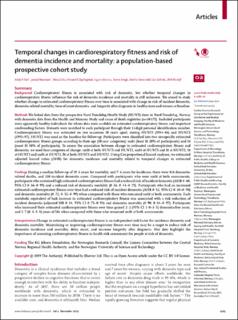| dc.contributor.author | Tari, Atefe R | |
| dc.contributor.author | Nauman, Javaid | |
| dc.contributor.author | Zisko, Nina | |
| dc.contributor.author | Skjellegrind, Håvard | |
| dc.contributor.author | Bosnes, Ingunn | |
| dc.contributor.author | Bergh, Sverre | |
| dc.contributor.author | Stensvold, Dorthe | |
| dc.contributor.author | Selbæk, Geir | |
| dc.contributor.author | Wisløff, Ulrik | |
| dc.coverage.spatial | Norway | en_US |
| dc.date.accessioned | 2020-05-12T13:58:29Z | |
| dc.date.available | 2020-05-12T13:58:29Z | |
| dc.date.created | 2019-11-21T12:10:44Z | |
| dc.date.issued | 2019 | |
| dc.identifier.citation | The Lancet Public Health. 2019, 4 (11), e565-e574. | en_US |
| dc.identifier.issn | 2468-2667 | |
| dc.identifier.uri | https://hdl.handle.net/11250/2654132 | |
| dc.description.abstract | Cardiorespiratory fitness is associated with risk of dementia, but whether temporal changes in cardiorespiratory fitness influence the risk of dementia incidence and mortality is still unknown. We aimed to study whether change in estimated cardiorespiratory fitness over time is associated with change in risk of incident dementia, dementia-related mortality, time of onset dementia, and longevity after diagnosis in healthy men and women at baseline. Methods We linked data from the prospective Nord-Trøndelag Health Study (HUNT) done in Nord-Trøndelag, Norway with dementia data from the Health and Memory Study and cause of death registries (n=30 375). Included participants were apparently healthy individuals for whom data were available on estimated cardiorespiratory fitness and important confounding factors. Datasets were matched to each participant through their 11-digit personal identification number. Cardiorespiratory fitness was estimated on two occasions 10 years apart, during HUNT1 (1984–86) and HUNT2 (1995–97). HUNT2 was used as the baseline for follow-up. Participants were classified into two sex-specific estimated cardiorespiratory fitness groups according to their age (10-year categories): unfit (least fit 20% of participants) and fit (most fit 80% of participants). To assess the association between change in estimated cardiorespiratory fitness and dementia, we used four categories of change: unfit at both HUNT1 and HUNT2, unfit at HUNT1 and fit at HUNT2, fit at HUNT1 and unfit at HUNT2, fit at both HUNT1 and HUNT2. Using Cox proportional hazard analyses, we estimated adjusted hazard ratios (AHR) for dementia incidence and mortality related to temporal changes in estimated cardiorespiratory fitness. Findings During a median follow-up of 19·6 years for mortality, and 7·6 years for incidence, there were 814 dementia-related deaths, and 320 incident dementia cases. Compared with participants who were unfit at both assessments, participants who sustained high estimated cardiorespiratory fitness had a reduced risk of incident dementia (AHR 0·60, 95% CI 0·36–0·99) and a reduced risk of dementia mortality (0·56, 0·43–0·75). Participants who had an increased estimated cardiorespiratory fitness over time had a reduced risk of incident dementia (AHR 0·52, 95% CI 0·30–0·90) and dementia mortality (0·72, 0·52–0·99) when compared with those who remained unfit at both assessments. Each metabolic equivalent of task increase in estimated cardiorespiratory fitness was associated with a risk reduction of incident dementia (adjusted HR 0·84, 95% CI 0·75–0·93) and dementia mortality (0·90, 0·84–0·97). Participants who increased their estimated cardiorespiratory fitness over time gained 2·2 (95% CI 1·0–3·5) dementia-free years, and 2·7 (0·4–5·8) years of life when compared with those who remained unfit at both assessments. Interpretation Change in estimated cardiorespiratory fitness is an independent risk factor for incidence dementia and dementia mortality. Maintaining or improving cardiorespiratory fitness over time may be a target to reduce risk of dementia incidence and mortality, delay onset, and increase longevity after diagnosis. Our data highlight the importance of assessing cardiorespiratory fitness in health risk assessment for people at risk of dementia. | en_US |
| dc.description.sponsorship | The KG Jebsen Foundation, the Norwegian Research Council, the Liaison Committee between the Central Norway Regional Health Authority, and the Norwegian University of Science and Technology. | en_US |
| dc.language.iso | eng | en_US |
| dc.rights | Attribution-NonCommercial-NoDerivatives 4.0 Internasjonal | * |
| dc.rights.uri | http://creativecommons.org/licenses/by-nc-nd/4.0/deed.no | * |
| dc.subject | Temporal changes | en_US |
| dc.subject | dementia | en_US |
| dc.subject | cardiorespiratory fitness | en_US |
| dc.subject | cohort study | en_US |
| dc.subject | time of onset dementia | en_US |
| dc.subject | Norway | en_US |
| dc.subject | dementia incidence and mortality | en_US |
| dc.subject | regular physical activity | en_US |
| dc.title | Temporal changes in cardiorespiratory fitness and risk of dementia incidence and mortality: a population-based prospective cohort study | en_US |
| dc.type | Peer reviewed | en_US |
| dc.type | Journal article | en_US |
| dc.description.version | publishedVersion | en_US |
| dc.rights.holder | Copyright © 2019 The Author(s). Published by Elsevier Ltd.
This is an Open Access article under the CC BY 4.0 license. | en_US |
| dc.source.pagenumber | e565-e574 | en_US |
| dc.source.volume | 4 | en_US |
| dc.source.journal | The Lancet Public Health | en_US |
| dc.source.issue | 11 | en_US |
| dc.identifier.doi | 10.1016/S2468-2667(19)30183-5 | |
| dc.identifier.cristin | 1750435 | |
| cristin.ispublished | true | |
| cristin.fulltext | original | |
| cristin.qualitycode | 1 | |

